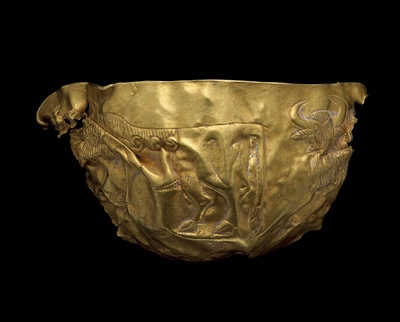Bronze Age Culture of Afghanistan
An urban culture developed in northern Afghanistan some four thousand years ago. Its distinctive style of architecture featured massive fortified buildings with towers constructed of unbaked bricks. As this culture had no known writing, its original name is lost, but archaeologists call it the "Oxus civilization," after the Oxus River (modern Amu Darya) which flows through the region. In 1966 farmers near the northern Afghan village of Fullol accidentally discovered a burial cache that contained the first evidence of the Oxus civilization in Afghanistan. The grave contained several bowls made of gold that most likely came from the Oxus riverbed.
Their designs include animal imagery such as bearded bulls (fig.1) from distant Mesopotamian and Indus valley cultures (present-day Pakistan), indicating that already at this early date, Afghanistan was part of an extensive trade network.

